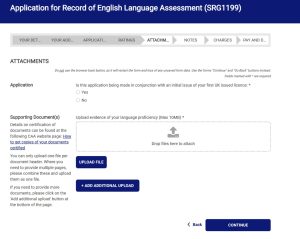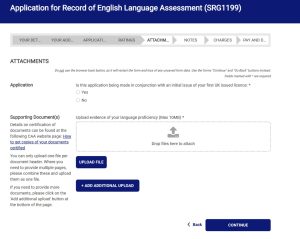Sailplane Pilot Licence Conversion
UK regulation requires that the pilot of a Part-21 sailplane (effectively all sailplanes other than certain vintage types) to hold an SPL (Sailplane Pilot Licence), unless they are flying as a student pilot.
To ensure that all qualified BGA glider pilots will have an SPL with the correct privileges when required, the BGA established a CAA-approved SPL conversion application and checking procedure that results in a painless application process. Thousands of pilots at BGA clubs now hold an SPL.
For a variety of reasons, not all pilots have converted to an SPL by the law-change deadline of 30th September 2025. The BGA is continuing to process SPL conversion applications beyond that date. Please note that where experience or qualification is quoted as part of the conversion, the experience or qualification must have been achieved prior to the 1st of October 2025. If you are unsure about BGA qualifications or simply forgot to apply at the time, please get in touch with the BGA office. There’s almost always a straightforward solution.
The minimum BGA gliding qualification for conversion to SPL is the BGA Bronze and Cross Country Endorsements achieved prior to 1st of October 2025. The Cross-Country Endorsement is not required for those who achieved Silver Distance prior to 1996 (as recorded by the BGA). Details of these BGA qualifications are held by the BGA and therefore applicants do not need to supply evidence with their application.
It is important that you read the following detail before filling in your application. For most pilots, its really straightforward, but most will find the information helpful.
Click here for the SPL application
Can I use SPL/BI(S)/FI(S) privileges if I have not yet received my licence?
No. The licence must be signed by the licence holder for it to become valid.
What happens once I have an SPL?
Nothing happens. Once you start using the privileges of your SPL, you will need to ensure you meet the published minimum ‘recency’ requirements. And that’s essentially it. Very little changes.
If I do not meet the conversion requirement or do not apply for an SPL in time, how can I continue to fly?
Don’t worry. If you don’t have an SPL, you’re effectively a student pilot. The SFCL rules note that “a student pilot shall not fly solo unless authorised to do so and supervised by an Flight Instructor (Sailplanes)”. So your club instructors will need to continue to supervise your flying.
After the 30th September 2025, on completion of the SPL training syllabus (previous BGA training can be transferred), a student pilot takes an assessment of competence with a Flight Examiner (Sailplanes), following which an SPL can be issued. Read about the SPL here.
Is there a minimum age to hold an SPL?
Yes. Applicants for an SPL must be at least 16 years old. An SPL holder under the age of 18 can carry a passenger (providing they meet all other requirements). A BI(S) is required to be at least 16 years old and an FI(S) at least 18 years old.
Do I need a CAA medical certificate to convert to an SPL?
For conversion from a BGA gliding certificate to an SPL, one of the following is required: CAA Pilot Medical Declaration (PMD), or LAPL medical certificate, or Class 2 or 1 medical certificate.
If I have a LAPL(S), do I need to exchange it for an SPL?
No. A Part-FCL LAPL(S) and a Part-FCL SPL are both automatically deemed to be an SFCL SPL. When the CAA reissues a licence for administrative reasons or upon application by licence holders, the CAA will replace Part-FCL sailplane licence for an SFCL SPL.
Once I have an SPL, how do I manage recency requirements?
The SPL is a lifetime licence. The privileges of an SPL including instructing can be exercised as long as the recency requirements have been met. Rolling recency guidance is available here.
Adding existing FRTOL privileges at the same time as applying to convert to an SPL – read carefully!
If you want to add existing FRTOL privileges to your SPL on conversion, the BGA’s conversion application form provides that facility. The CAA will check their database to ensure the applicant holds an FRTOL with level 6 English language proficiency. They will then add the applicants existing FRTOL privileges to the new SPL.
If an applicant is not sure whether level 6 English language proficiency is recorded by CAA, the CAA can supply the information. Contact fclweb@caa.co.uk. If you do not tick the box or If the CAA does not have a record of the applicant attaining a demonstrated level 6 English proficiency, there is a risk losing existing FRTOL privileges.
Full details are on the CAA website.
If you do not have English language proficiency 6 (ELP6) annotated on your existing FRTOL, please follow this guidance:
Download, print and complete* the SRG 5012.
Complete the CAA online form SRG 1199
When you see this page…upload a scanned copy of your completed SRG 5012.
Complete the online form and send a copy of the receipt to the BGA with your SPL application as evidence that your FRTOL has been updated.
*An FE(S) can assess and certify the language proficiency. Note: level 6 is an expert speaker of English, e.g. a native speaker.
Applying for an FRTOL at the same time as applying to convert to an SPL – read carefully!
How to convert to an SPL is described above. Some applicants may wish to apply for FRTOL privileges at the same time as applying for an SPL. The CAA process is somewhat complex. So the BGA has developed and verified guidance to assist applicants which is detailed in one of the two pdf documents available at ‘Applying for your FRTOL at the same time as your SPL’. The other of the two pdf documents at that link is a ‘placeholder’, which is referred to in the detailed guidance. For anyone who having read the guidance needs to complete a CAA Form 5003, the form is available here.
Adding an ELP6 to an existing FRTOL
If you do not have English language proficiency 6 (ELP6) annotated on your existing FRTOL, please follow this guidance.
Download, print and complete* the SRG 5012.
Complete the CAA online form SRG 1199
When you see this page…
…upload a scanned copy of your completed SRG 5012.
Complete the online form and send a copy of the receipt to the BGA with your SPL application as evidence that your FRTOL has been updated.
*An FE(S) can assess and certify the language proficiency. Note: level 6 is an expert speaker of English, e.g. a native speaker.
Applying to convert to a Sailplane Pilot Licence (SPL)
The step by step process for converting an SPL where the experience or qualification being converted was achieved prior to 1st of October 2025 is:
- Consider whether you need to obtain a medical certificate, or qualify further under the BGA system before converting.
- Decide what additional qualifications you are going to apply for. The application form guidance is very helpful.
- Print, read, and complete the application form and guidance available at this link (CLICK HERE).
- Check that your application is complete, including certified and clearly readable copies of documents where required.
- Send your complete application including including certified and clearly readable copies of documents where required by post BGA, 8 Merus Court, Meridian Business Park, Leicester, LE19 1RJ, or email lizzie@gliding.co.uk
Adding a privilege to the SPL through conversion after the licence has been issued
The step by step process for adding a privilege to an SPL where the experience or qualification being converted was achieved prior to 1st of October 2025 is:
- Consider which Part-SFCL privileges you believe you want to add.
- Refer to the SPL conversion guidance and ensure that you meet the requirements.
- Complete this ‘adding a privilege’ application form.
- Check that your application is complete, including certified or original and clearly readable copies of documents where required
- Send your application to; BGA 8 Merus Court, Meridian Business Park, Leicester, LE19 1RJ
- CAA should replace your existing licence with an SFCL SPL.
SFCL FAQs
More Information
Clearly the first port of call for any licence conversion queries is the information published on this website. Where that doesn’t provide the answer, the BGA office staff are always happy to help.

